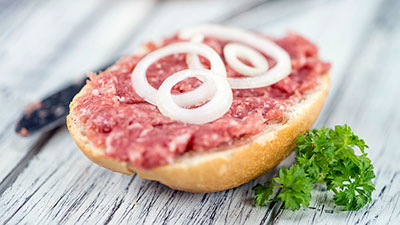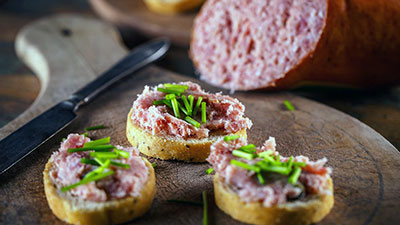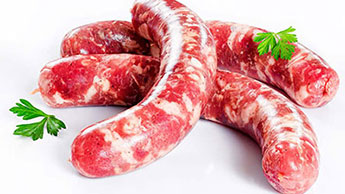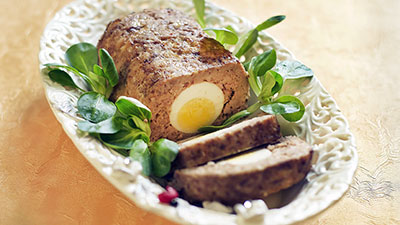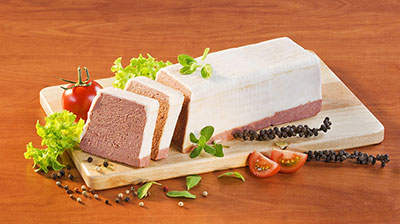Meats and Sausages
German Sausages
There are hundreds of German sausages; to better understand them it would be beneficial to know how they are classified and named. The German sausages are named by the method of production (fermenting and drying or cooking), the type of meat, filler material or spice used, and the region or the city where they were made. With all due credit given to Greeks and Romans, who were the first ones to make sausages, the undisputed fact remains that Germany, with its over 1,000 sausages remains the world’s sausage capital.
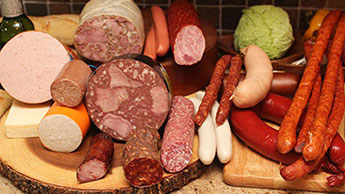
Many German sausages have a long tradition: Thüringer Rostbratwurst dates back to 1404, Feldgieker-1488, Eichsfelder Feldgieker-1718, and many others are 100-200 years old. The number of German sausages is mind-boggling, and it is impossible to estimate the exact number, all we can say is that there are plenty, way over 1000. Most popular sausages are covered in The German Guide to Meats and Meat Products - Leitsätze für Fleisch und Fleischerzeugnisse. Section 2.2 describes sausage types, their names, and material selection. It specifies what meat and in what proportion is used for different sausages, whether it is cured or not, the degree of comminution (fine or coarse), and the size of casings. The guide does not discuss spice selection, temperatures, or manufacturing processes. The guide lists 435 sausages.
The Austrian Guide to Food Products (Part/B14/Meats and Meat Products)-Österreichisches Lebensmittelbuch, Codexkapitel/B14/Fleisch und Fleischerzeugnisse lists 139 sausages. Adding both guides together comes to 574 sausages. Both guides include only historically well-established sausages, however, there are many more sausages that are known to exist. There are low-fat sausages, wild game sausages, and so on.
Classification of German Sausages (Wurstwaren)
Rohwürste
These are raw sausages, basically, fermented sausages (not cooked), having red color - made with sodium nitrite (Cure #1 or Cure #2), can be stored at 10° C (50° F), and usually cold smoked. They are further subdivided into:
Schnittfeste Rohwürste - sliceable raw sausages characterized by coarse grind, firm texture, and long shelf life. Usually made with starter culture and cold smoked. White mold is often present on the surface. They can be kept at room temperature. Typical examples: Salami, Feldkieker, Plockwurst, Berliner Knacker.
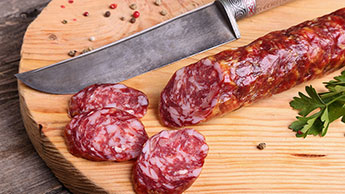
Streichfähige Rohwürste - spreadable raw sausages. They are made with softer fats in order to be spreadable, fine grind (occasionally coarse or medium) with a shorter drying process and a shorter shelf life than the sliceable ones, usually cold smoked. They should be refrigerated. Typical examples: Teewurst, Braunschweiger, Grobe Mettwurst.
Rohwurst – Gegart
The German word “gegart” means “cooked or steamed”. You can find in German books sausages classified as cooked raw sausages, yet they were not fermented, so there is a little dilemma – cooked meat is not raw anymore, right? You can often find Kochsalami (smoked or not) classified as Rohwurst, which makes a little sense as the sausage is not fermented. This naming system is not limited to Germany as one can find Kochsalami (cooked salami) in the USA and other countries. The only thing in common they have with salami or any Rohwurst is the look and the diameter of the slices. They are made with cured meat so the slices are red with visible specks of white fat. They are actually Brühwurst (cooked in water) sausages.
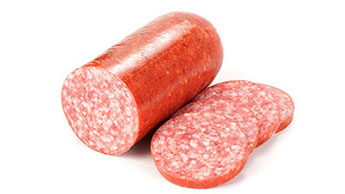
Brühwürste
The biggest group of sausages, which are made through scalding, baking, or frying, usually right after stuffing. By scalding it is meant to cook sausages in water at 75-80° C (167-176° F).
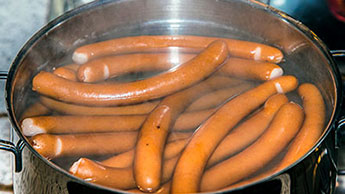
They are subdivided into:
Brühwürstchen - these shorter, scalded sausages are stuffed into 22-32 mm diameter casings. The majority of popular snack sausages belong to this group: Wiener, Bockwurst, Bratwurst, Frankfurter, Münchener Weiꞵwurst. They need to be refrigerated and consumed relatively fast.
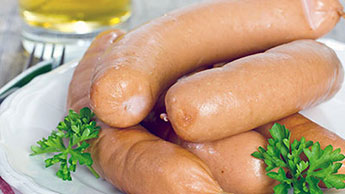
Brühwürste, fein zerkleinert - finely ground Brühwürste sausages. These sausages are ground through 2-3 mm (1/8”) plate, often 2-3 times and 10-20% water is added during the process. Commercial processors emulsify them to paste consistency using bowl cutters. These sausages are stuffed into larger diameter casings (40-90 mm) and are also longer, at an average of around 50 cm (20”). Typical examples: Lyoner, Serdellenwurst, Knoblauchwurst, Norddeutsche Mortadella, Gelbwurst.
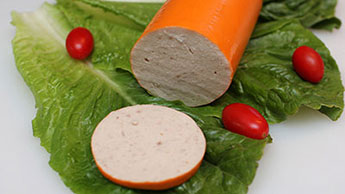
Grobe Brühwurste - coarsely ground Brühwürste sausages. Göttinger, Blasenwurst, Krakauer, Tiroler, Bierwurst, Grobe Schinkenwurst, Bierkugel. These sausages are stuffed into larger diameter casings (40 mm - 90 mm) and are also longer, at an average of around 50 cm (20”). Typical examples: Göttinger, Blasenwurst, Krakauer, Tiroler, Bierwurst, Grobe Schinkenwurst, Bierkugel.
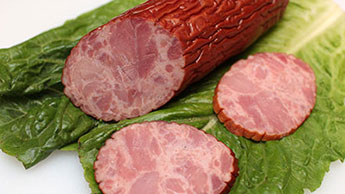
Brühwurst mit Einlagen - scalded sausages made with finely ground base material and larger meat inserts such as diced tongue, pieces of heart, and diced hard fat. Typical examples: Bierschinken, Krakauer, Zungenwurst, Süddeutsche Mortadella.
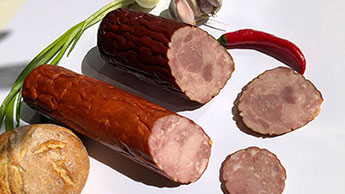
Bratwurst
Bratwurst is a German sausage with a worldwide recognition. The name bratwurst comes from the old German word “brät” (describing the finely-ground sausage mass), and the original spelling was indeed “Brätwurst”. Over the years, the dots above the letter ‘a’ have disappeared. German processors use a prepared in advance base material for making many sausages called brät (sausage meat). Bratwurst is quite similar to Brühwurst water cooked sausages, however, it contains less water and generally the sausage is not fully cooked so it is a fresh sausage that needs to be refrigerated. It may be cooked for a few minutes in hot water before serving (optional), and then fried or grilled.
Red color in bratwurst is normally not desired so the sausage is usually made without sodium nitrite. To make bratwurst even lighter, instead of water, the full milk is added when mixing or emulsifying. For better binding of materials add 2 egg whites for 1 kg of sausage material, but the sausage should be either consumed within a day or two or scalded in hot water at 80° C (176° F) for 20 minutes. Burst sausage is a common complaint that can be caused when the sausage mix is hard and the casing is too firmly filled. Keep in mind that sheep casings are more delicate than other types.
German sausage recipes are very traditional, there is not much improvisation or new spice combinations. You can, however, make your bratwurst the way you like by adding oregano, Spanish smoked paprika (pimentón), cayenne pepper, Tabasco sauce or herbs, and even vegetables. Bratwurst is made with pork, pork and veal, pork and beef and almost always with pork belly. Commercial processors cut meat for Brühwurst and Bratwurst in bowl cutters, adding crushed ice or cold water at about 20%, ie. 80% meat and 20% water. Bratwurst is meant to be consumed soon, which is why its production often ends with stuffing. Then, it is refrigerated and eaten the same or the next day with frying or grilling being the preferred method of cooking.
Kochwürste
These sausages are made from pre-cooked meats and materials. (kochen means “to cook” or “to boil”). After stuffing these sausages are cooked in water again. They are usually cut and served cold, though blood sausages are served hot as well. This group of special sausages is still subdivided into:
Kochstreichwürste - spreadable sausages containing liver, i.e. pâté and liver sausages.
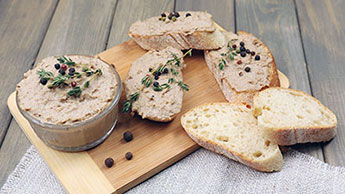
Pasteten - high-quality products, usually, but not always, containing liver, not stuffed into casings but placed and cooked in forms (molds). Typical examples: Leberpastete, Gänseleberpastete, Geflügelpastete, Wildpastete.
Leberwürste (liver) These Kochwürste sausages contain liver (pork, poultry, occasionally a little beef liver), pork fat, meat, onions, mushrooms, spices. Typical examples: Kalbsleberwurst, Champignonleberwurst, Sahneleberwurst, Sardellenleberwurst.
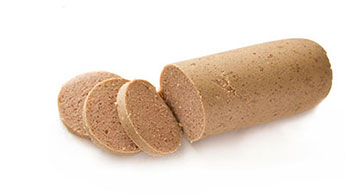
Kochmettwürste - typical examples: Schinkencreme, Gekochte Mettwurst, Semmelwurst, Zwiebelwurst.
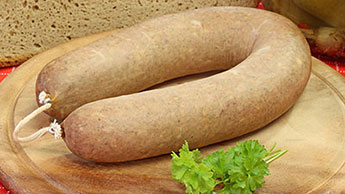
Blutwürste (blood sausages). These Kochwürste sausages contain blood, meat, fat, and often filler material like groats, rice, and white bread. Typical examples: Thüringer Blutwurst, Blutwurst mit Semmeln, Flönz, Beutelwurst, Blunzen.
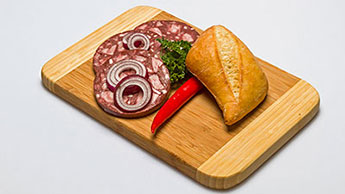
Sülzwürste - Kochwürste (cooked) sausages made with aspic or gelatin such as head cheeses and meat jellies.
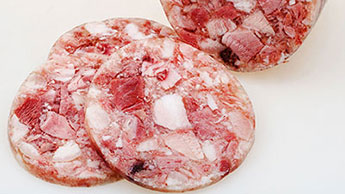
Sülzen - pieces of meat from pork, beef, poultry, or fish, cut or diced, mixed in natural gelatin (meat stock) made from boiling meats rich in connective tissue (sinews, skins). Product packed either in form/mold or in natural or synthetic casings (traditionally in pork stomach). Typical examples: Weinsülze, Sülze, Sülzwurst, Bauernsülze, Hausmachersülze, Geflügelsülzwurst.
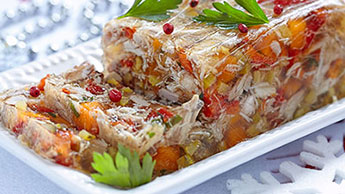
The German Official Guide to Meats and Meat Products - Leitsätze für Fleisch und Fleischerzeugnisse lists historically established sausages, however, there are more types of sausages that are popular such as:
Kochwurst mit Nährmitteln (Cooked Sausages with Filler Material). Those sausages follow rules for making cooked sausages (Kochwürste). They are made from precooked materials but do not contain blood, liver or aspic. Popular filler material is: oats, barley, buckwheat groats, rice, pumpkin, potatoes, white bread and rolls, and flours. Then, there are sausages made with poultry, wild game meat and reduced fat.
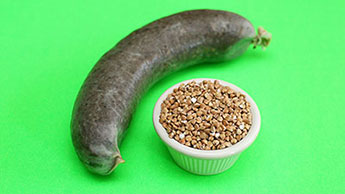
Naming German Sausages
Many Austrian sausages carry their own distinctive names, others have the same names as the sausages in Germany. After all, Germany and Austria speak the same language and both countries were once parts of the same Austro-Hungarian Empire (1867 and 1918).
Most people are familiar with popular German sausages such as Bratwurst, Bockwurst, Liverwurst, or Braunschweiger; these sausages are known worldwide and although they are different from each other, yet they do not need to be translated into English as the consumer understands what they are.
The world of sausages becomes, however, confusing when we see descriptions such as:
Bouillonwürstchen, Fleischwürstchen, Jauersche, Knobländer, Pfälzer, Augsburger, Regensburger, Jagdwürstchen, Brüpolnische, Bauernwürstchen, Bauernwurst, Rindswurst, Rindersalami, Schlockwurst, Cervelatwurst, Schinkenmettwurst, Feldkieker (Feldgicker), Berliner Knacker, Bauernbratwurst, Braunschweiger Mettwurst, Zweibelmettwurst, Wollwurst, Münchener Weiꞵwurst, Stockwurst. Kalbsbratwurst, Weiꞵwurst, Göttinger, Blasenwurst, Braunschweiger Leberwurst, Frankfurter Leberwurst, Fränkische Leberwurst, Hamburger Hausmacherleberwurst, Thüringer Blutwurst, Dresdner Blutwurst, Rotwurst, Calenberger Rotwurst, Bauernrotwurst, Hausmacherrotwurst, Schinkensülzwurst.
There are hundreds if not thousands of different German sausages, so to better understand them it would be beneficial to know how they are classified and named. It was decided to leave the German names alone, however, each recipe includes its original name and the English translation., Leaving original names intact makes it easier to search for more information about a particular sausage on the Internet.
“Wurst” is a general term for the “sausage” and "würstchen" denotes a "small sausage". The composition of the sausage may remain the same; the difference is in size, for example, Kümmelwurst and Kümmelwürstchen. It will be a waste of time asking for a “wurst” in a meat store as all sausages can be called “wurst”. The salesperson would ask, “Which one?” as each of his sausages can be correctly called “wurst”. In most sausages, the first part of the name describes the type or origin of the sausage, and the “wurst” is attached to it.
Wurst = sausage, Bauernwurst
Würstchen = small sausage, Bauernwürstchen
The German sausages are named after:
Type of the sausage
- Blut = blood, Blutwurst (Blood Sausage)
- Leber = liver, Leberwurst (Liver Sausage)
- Sülz = denotes head cheese. Sülzwurst (Head cheese)
- Bratwurst = minced meat. Bratwurst is preceded by the region, the city of its origin ot a method of cooking - Pfalzer Bratwurst, Hessische Bratwurst, Rostbratwurst, Rheinische Bratwurst
The main ingredient
- Zungenblutwurst (Tongue Blood Sausage), Knoblauchwurst (Garlic Sausage)
- Currywurst (Curry Sausage), Reisewurst (Rice Sausage), Kartoffelwurst (Potato Sausage), Erbswurst (Pea Sausage)
The color
- Gelb = yellow, Gelbwurst (Yellow sausage)
- Rot = red, Rotwurst (Red sausage, usually denotes blood or blood sausage)
- Weiꞵ = white, Weiꞵwurst (White sausage), Münchener Weiꞵwurst
The city or the region in which the sausage was made:
German cities known for their sausages:
- Berlin: Berliner Mettwurst, Berliner Leberwurst, Berliner Knackwurst.
- Hamburg: Hamburger Bratwurst, Hamburger Knackwurst.
- Hannover: Hannoversche Leberwurst, Hannoversche Hirnwurst.
- Frankfurt: Frankfurter Blutwurst, Frankfurter Leberwurst.
Sausage making regions
Sausages are produced all over Germany and Austria, however, certain regions have been known for producing outstanding sausages for centuries. These are Bavaria and Thuringia. In the North, people have access to the sea, so it’s not surprising that they eat sardine sausages (Hamburger Sardellenwurst, Sardellenleberwurst).
Bavaria borders Austria, the Czech Republic, Switzerland, as well as the neighboring German states of Baden-Wuerttemberg, Hesse, Thuringia, and Saxony. The capital city of Bavaria is Munich (München), which is known for its famous held in Munich October-fest (15-18 day festival). Bavarian cities that are known for great sausages include: Munich (München) Nuremberg (Nürnberg), Augsburg, Würzburg, and Regensburg.
Bavarian sausages: Münchener Weiꞵwurst, Nürnberger Bratwurst, Augsburger, Regensburger Knacker.
Thuringian sausages: Thüringer Mettwurst, Thüringer Leberwurst, Thüringer Sülzwurst.
Sausage names like Bratwurst, Kochwurst, Rohwurst, Brühwurst, Blutwurst, or Leberwurst do not represent a particular German sausage but a sausage type. For example, Italienische Bratwurst (Italian Bratwurst), Spanische Bratwurst (Spanish Bratwurst), or Bratwurst mit Ei und Milch (Bratwurst with Egg and Milk) all are bratwurst sausages designed for frying/grilling. You might have two different sausage types yet the same name, for example Knackwurst. There is a raw (fermented) Knackwurst and a scalded Knackwurst (cooked in water). The name remains the same, but the sausages have different characteristics, textures, and flavors.
There once were popular sausages such as Milzwurst (spleen), Herzwurst (heart), Lungenwurst (lungs), Kopfwurst (head), but nowadays people shy away from such products, besides, it becomes increasingly difficult, at least for people in metropolitan areas, to purchase such meats.
Smoking sausages
Smoked meats and sausages are very popular in Germany and in East European countries like Poland and Russia. Germans are strict with smoking temperature, there is not such a thing as 30° C (86° F) cold smoke. German sausages are smoked with cold smoke at 18-25° C (64-77° F) and hot smoke at 60-70° C (140-158° F). Cold smoking is drying with smoke and it is not a continuous process. Having occasional breaks without smoke is permitted.Beechwood was traditionally used for smoking many sausages, but the truth is that people usually use wood that grows in the area, for example, alder or oak. Occasionally, when a different flavor was desired, for example, when smoking game sausages, juniper twigs and berries were added to the fire.
German sausage recipes
There are hundreds of great German sausage recipes and it would be impractical to list all of them on one page, but the most popular ones are listed below:
- Aalrauchmettwurst - fermented
- Aachener Weihnachtsleberwurst - liver
- Augsburger-Austrian - boiled
- Augsburger-German - boiled
- Battered Sausage - cooked
- Bauernbratwurst - fermented
- Bauernleberwurst - liver
- Bayerische Bierwurst - boiled
- Berliner Dampfwurst - boiled
- Berliner Knacker - fermented
- Berliner Leberwurst - liver
- Berliner Sülzwurst - head-cheese
- Beutelwurst - blood
- Bierschinken - boiled
- Bierwurst - boiled
- Blunzn - blood
- Blutwurst mit Buchenweizengrütze - blood
- Blutwurst mit Gerstengrütze - blood
- Blutwurst mit Graupen - blood
- Blutwurst mit Hafergrütze - blood
- Blutwurst mit Kürbis - blood
- Blutwurst mit Roggenschrot - blood
- Blutwurst mit Schrippen - blood
- Bockwurst - fresh
- Bologna-German - boiled
- Bratblutwurst - blood
- Bratleberwurst - liver
- Bratwurst - fresh
- Bratwurst-Austrian - fresh
- Bratwurst-Curry - boiled
- Bratwurst-Hamburger - fresh
- Bratwurst With Egg and Milk - fresh
- Braunschweiger Liver Sausage - liver
- Braunschweiger Mettwurst-Sliceable - fermented
- Braunschweiger Mettwurst-Spreadable - fermented
- Breinwurst - boiled
- Burenwurst - boiled
- Burgenländisches Hauswürstel - boiled
- Cabanossi-Austrian - baked
- Cabanossi-German - boiled
- Cervelatwurst - fermented
- Champignonleberwurst - liver
- Cocktailwürstchen - boiled
- Currywurst - cooked
- Debreziner-Austrian - boiled
- Debreziner-German - boiled
- Deutsche Salami - fermented
- Dürre - baked
- Dürre Runde - fermented
- Eichsfelder Feldgieker - fermented
- Erbswurst - cooked
- Extrawurst - boiled
- Feine Bratwurst - boiled
- Feldkieker (Feldgicker) - fermented
- Fleischwurst - boiled
- Flönz - blood
- Frankfurter - cooked
- Frankfurter - All Beef - boiled
- Frankfurter-Wiener Würstel - boiled
- Fränkische Bratwurst - fresh
- Frankfort Liver Sausage - liver
- Frankfort Yellow Liver Sausage - liver
- Fried Sausage - cooked
- Gänseleberwurst - liver
- Geflügelleberwurst - liver
- Gelbwurst - cooked
- Geräucherte Bratwurst - fermented
- Goose or Duck Head Cheese - head cheese
- Gothaer - fermented
- Götinger Feldkieker - fermented
- Götinger Stracke - fermented
- Greuβener Salami - fermented
- Grützleberwurst - liver
- Gutsfleischwurst - blood
- Halberstädter Wurstchen - cooked
- Ham Sausage-German - cooked
- Harzer Schmorwurst - boiled
- Hausmacherblutwurst - blood
- Hausmacherleberwurst - liver
- Haussalami - fermented
- Hessische Sülzwurst - head-cheese
- Hofer Rindfleischwurst - fermented
- Holsteiner - fermented
- Jadgwurst - cooked
- Jauersche - boiled
- Jauntaler Salami - fermented
- Kalbsbratwurst - boiled
- Kalbsleberwurst - liver
- Kartoffelwurst-Boiled Potatoes - cooked
- Kartoffelwurst-Raw Potatoes - cooked
- Katenrauchwurst - fermented
- Kawassy - cooked
- Klobasse - boiled
- Klöpfer - boiled
- Knacker - boiled
- Knackwurst - boiled
- Knoblauchwurst - boiled
- Kochsalami - boiled
- Kohlwurst - fermented
- Kohlwurst-Lippsche - fermented
- Krainer - boiled
- Krakauer - boiled
- Kummelwurst - cooked
- Kummelwurst - fermented
- Landjager - fermented
- Leberrotwurst - blood
- Leberstreichwurst - liver
- Leberwurst - liver
- Leberwurst mit Reis Liver Sausage with Rice
- Leberwürstchen - liver
- Luftgetrocknete Mettwurst - fermented
- Lyoner - boiled
- Mettwurst-Spreadable - fermented
- Mortadella-Deutsch with Peppers - boiled
- Mortadella–Norddeutsche - boiled
- Mortadella–Süddeutsch - boiled
- Münchener Rostbratwurst - fresh
- Münchener Weisswurst - boiled
- Nürnberger Bratwürste - fresh
- Oecher Puttes - blood
- Pariser - boiled
- Pariser Fleischwurst - boiled
- Pfälzer Bratwurst - fresh
- Pig’s Feet and Calf’s Tongue Head Cheese - head cheese
- Pinkelwurst - boiled
- Plockwurst - fermented
- Polnische - boiled
- Poultry Bouillon Head Cheese or Gelatine - head cheese
- Presskopf - cooked
- Presswurst - head-cheese
- Putenleberwurst - liver
- Reiswurst (Rice Sausage) - boiled
- Rheinische Bratwurst - fresh
- Rheinische Bratwurst Smoked - cooked
- Rheinische Mettwurst - fermented
- Rindswurst (Beef Sausage) - boiled
- Rostbratwurst - boiled
- Rote - boiled
- Rotwurst - blood
- Sächsische Mettwurst - fermented
- Sahneleberwurst Liver Sausage With Cream
- Salametti - fermented
- Salami-German - fermented
- Salami-Mailänder - fermented
- Salzburger - boiled
- Sardellenleberwurst Liver Sausage with Sardines
- Sardellenwurst - boiled
- Saumagen - boiled
- Saumaise - boiled
- Schinkenwurst - boiled
- Schlackwurst - fermented
- Schlesische Bratwurst - fresh
- Schmierwurst - fermented
- Schüblinge - boiled
- Schwineleberwurst - liver
- Semmelleberwurst - liver
- Servela - boiled
- Speckwurst - boiled
- Stadtwurst - boiled
- Stadwurst-Nurnberger - boiled
- Sulz-Austrian - head-cheese
- Sülze - head-cheese
- Sülzwurst - head-cheese
- Teewurst - fermented
- Teewurst Rügenwalder Art - fermented
- Thüringer - fermented
- Thüringer Bratwurst - fresh
- Thüringer Leberwurst - liver
- Thüringer Rostbratwurst - fresh
- Thüringer Rotwurst - blood
- Tiroler - boiled
- Tomatenleberwurst - liver
- Touristenwurst - fermented
- Touristenwürstchen - boiled
- Waldviertler - boiled
- Weinsülze - head-cheese
- Weiβe Zungenwurst - boiled
- Weiꞵkrautwürstchen - baked
- Weiβwurst - fresh
- Westfälische Mettwurst - fermented
- Wiener - cooked
- Wiener-Austrian - boiled
- Wild Bratwurst - fresh
- Wollwurst - boiled
- Zervelatwurst - fermented
- Zungenblutwurst - blood
- Zweibelwurst - cooked
- Eichsfelder Feldgieker PGI 2013
- Greußener Salami PGI 1998
- Halberstädter Wurstchen PGI 2010
- Hofer Rindfleischwurst PGI 2010
- Oecher Puttes PGI 2016
- Thüringer Leberwurst PGI 2003
- Thüringer Rostbratwurst PGI 2003
- Thüringer Rotwurst PGI 2003
- Nürnberger Bratwürste; Nürnberger Rostbratwürste PGI 2003

